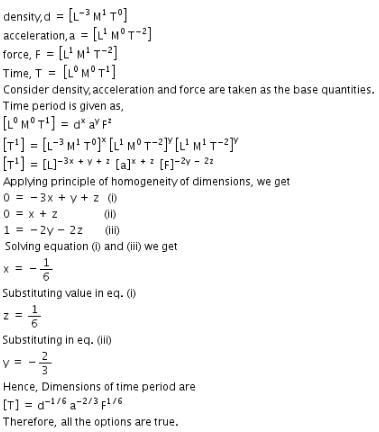Class 11 Exam > Class 11 Questions > If density D acceleration a and force F are t...
Start Learning for Free
If density D acceleration a and force F are taken as basic quantities then the time period has dimensions?
Verified Answer
If density D acceleration a and force F are taken as basic quantities ...

 This question is part of UPSC exam. View all Class 11 courses
This question is part of UPSC exam. View all Class 11 courses
Most Upvoted Answer
If density D acceleration a and force F are taken as basic quantities ...
Introduction:
Time period is the time taken by a complete oscillation or a complete cycle of a periodic motion. It is generally measured in seconds (s). In this question, we are supposed to find out the dimensions of time period using density (D), acceleration (a) and force (F) as basic quantities.
Analysis:
To find the dimensions of time period using D, a and F, we can use the method of dimensional analysis.
Step 1: Write the formula of time period:
The formula of time period (T) is given by:
T = 2π√(m/k)
where m is the mass of the object in motion and k is the spring constant of the spring.
Step 2: Substitute the basic quantities:
We can substitute the basic quantities (D, a and F) in the formula of time period as follows:
T = 2π√(m/k)
T = 2π√(D × V/k)
where V is the volume of the object in motion.
We know that force (F) is given by:
F = ma
where m is the mass of the object in motion and a is the acceleration.
Therefore, we can write:
a = F/m
m = D × V
Substituting these values in the formula of time period, we get:
T = 2π√(D × V/F) × √(F/m)
T = 2π√(D × V/F) × √(F/(D × V))
Simplifying the above expression, we get:
T = 2π√(D/F)
Step 3: Write the dimensions:
The dimensions of time period can be written as:
[T] = [D/F]^(1/2)
[T] = [M/L^3] × [L/T^2]^(-1/2)
[T] = [T]
Therefore, the dimensions of time period using density (D), acceleration (a) and force (F) as basic quantities are [T].
Conclusion:
The dimensions of time period using density (D), acceleration (a) and force (F) as basic quantities are [T]. This means that time period is a dimensionless quantity and is not dependent on any of the given basic quantities.
Attention Class 11 Students!
To make sure you are not studying endlessly, EduRev has designed Class 11 study material, with Structured Courses, Videos, & Test Series. Plus get personalized analysis, doubt solving and improvement plans to achieve a great score in Class 11.

|
Explore Courses for Class 11 exam
|

|
Similar Class 11 Doubts
If density D acceleration a and force F are taken as basic quantities then the time period has dimensions?
Question Description
If density D acceleration a and force F are taken as basic quantities then the time period has dimensions? for Class 11 2024 is part of Class 11 preparation. The Question and answers have been prepared according to the Class 11 exam syllabus. Information about If density D acceleration a and force F are taken as basic quantities then the time period has dimensions? covers all topics & solutions for Class 11 2024 Exam. Find important definitions, questions, meanings, examples, exercises and tests below for If density D acceleration a and force F are taken as basic quantities then the time period has dimensions?.
If density D acceleration a and force F are taken as basic quantities then the time period has dimensions? for Class 11 2024 is part of Class 11 preparation. The Question and answers have been prepared according to the Class 11 exam syllabus. Information about If density D acceleration a and force F are taken as basic quantities then the time period has dimensions? covers all topics & solutions for Class 11 2024 Exam. Find important definitions, questions, meanings, examples, exercises and tests below for If density D acceleration a and force F are taken as basic quantities then the time period has dimensions?.
Solutions for If density D acceleration a and force F are taken as basic quantities then the time period has dimensions? in English & in Hindi are available as part of our courses for Class 11.
Download more important topics, notes, lectures and mock test series for Class 11 Exam by signing up for free.
Here you can find the meaning of If density D acceleration a and force F are taken as basic quantities then the time period has dimensions? defined & explained in the simplest way possible. Besides giving the explanation of
If density D acceleration a and force F are taken as basic quantities then the time period has dimensions?, a detailed solution for If density D acceleration a and force F are taken as basic quantities then the time period has dimensions? has been provided alongside types of If density D acceleration a and force F are taken as basic quantities then the time period has dimensions? theory, EduRev gives you an
ample number of questions to practice If density D acceleration a and force F are taken as basic quantities then the time period has dimensions? tests, examples and also practice Class 11 tests.

|
Explore Courses for Class 11 exam
|

|
Suggested Free Tests
Signup for Free!
Signup to see your scores go up within 7 days! Learn & Practice with 1000+ FREE Notes, Videos & Tests.

























